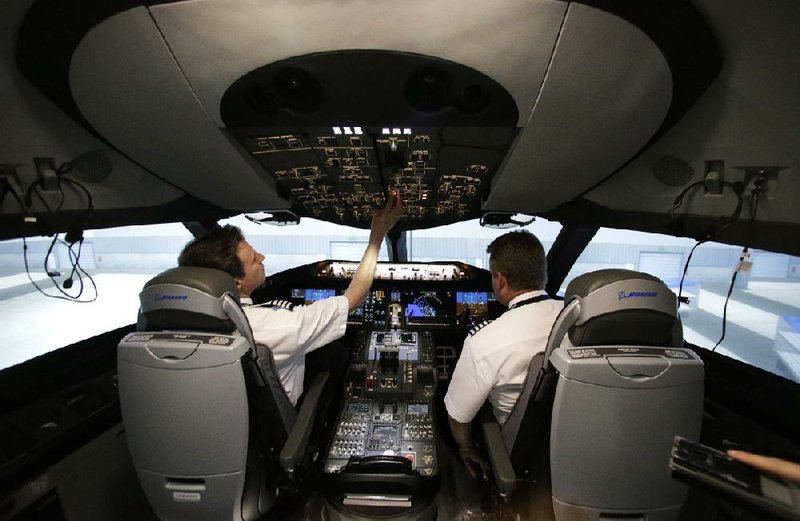FORT WORTH -- Rumbling down the runway at New York's JFK airport, American Airlines pilot Bill Elder points the nose of the Boeing 787 skyward and takes off for Denver.
Elder roars over the Atlantic, then banks sharply to the left, back over Queens and then Manhattan. But he is flying too low and triggers a ground-proximity warning as the Empire State Building appears off to the left.
Not to worry. The scene is unfolding in a flight simulator at American's training center in Texas. Elder, American's fleet training manager, is demonstrating the warning systems that mimic those in an airliner.
American will take delivery of its first 787, which Boeing calls the Dreamliner, in November. Passenger flights begin early next year. In the next few months, dozens of American Airlines pilots will sit in the same simulator and learn the nuances of the controls before they can fly the real plane.
The 787 could be American's most important new plane since the Boeing 777 in 1999. With its improved fuel efficiency and long range, the 787 could improve the airline's profit by making many international routes more economical.
But the plane has a turbulent record. Production was delayed two years, and the entire worldwide fleet of 50 was grounded last year after batteries overheated in two planes. Regulators allowed the jets to fly again after Boeing crafted a fix that included encasing the batteries in steel boxes to contain any fires.
The Dreamliner was the first big passenger jet to use lithium-ion batteries to power key systems. Last week, U.S. safety officials said the Federal Aviation Administration relied too much on Boeing for technical expertise and might not have adequately tested the batteries. Experts believe that lithium-ion batteries can short-circuit without warning, the investigators said.
American Airlines Group Inc. declined to make an executive available for comment. In a statement, the airline said it was "in constant dialogue with Boeing, and we look forward to adding the 787 to our fleet." American's former chief executive officer and current chairman, Tom Horton, similarly supported Boeing last year.
American will become just the second U.S. airline, after United, to fly the 787. Worldwide, about 140 are flying today, and Boeing says it has orders for nearly 900 more.
American has ordered 42 Dreamliners but hasn't yet said which routes they will fly. Spokesman Casey Norton said the plane will be tested on domestic routes before going into international service -- the same strategy used by United Airlines.
Richard Aboulafia, a prominent aviation consultant, said the Dreamliner will be crucial for American as it competes with United and Delta to attract premium passengers on international routes. He suggests that American will fly it to Asia, the Middle East and secondary cities in Europe.
"It is absolutely the plane you want to fly point to point internationally," he said, "and it's at its best at longer ranges" where the fuel efficiency pays off most.
United executives say the plane burns 20 percent less fuel than similar jets and scores highest in the airline's surveys of passengers. United plans to use the 787 on new flights this year between San Francisco and Chengdu, a Chinese city that has never had nonstop service from the U.S., and between Los Angeles and Melbourne, Australia.
The 787 "has allowed us to add more spokes to our network and do it economically," said Brian Znotins, United's vice president of network operations. The airline has 65 more on order, including new larger versions.
American won't say how much it will pay for the planes. The base model lists for $211.8 million on Boeing's website, but airlines routinely get deep discounts.
Even the simulator wasn't cheap. American wouldn't comment, but a spokesman for the manufacturer, Canada's CAE, said a 787 simulator would be at the "upper end" of a range between $11 million and $20 million.
Depending on their experience, American pilots will spend anywhere from 10 days to nearly a month in the simulator before graduating to practice flights with the real plane. Then come passenger trips, when they will be accompanied by an instructor called a check airman.
Jim Dees, American's training program chief for the 787 -- he and Elder are the only American pilots who have flown a Dreamliner -- said the simulator allows pilots to practice during emergencies and bad weather that wouldn't be safe in a real plane. They can pick from nearly two dozen airports for takeoffs and landings, including over-water approaches at San Francisco or mountainous terrain around Salt Lake City.
Letting a reporter take the first officer's seat, the pilots had him pull the nose up, push it down and roll from side to show how the 20,000-pound device with six gigantic legs simulates the rocking of a plane in flight. They even let him "land" in Denver.
"The feel on the controls," Elder said, "is just as if you were on an airplane."
Business on 05/28/2014
